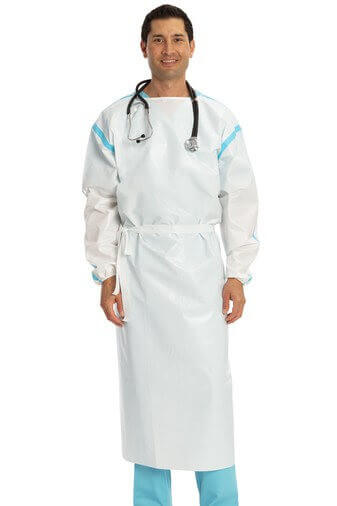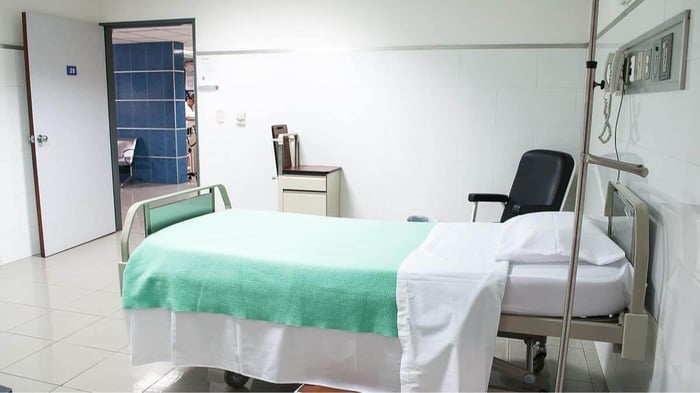One common question we get at Direct Textile Store is what is an Isolation Gown? Isolation gowns are examples of personal protective equipment used in health care settings. They are used to protect the wearer from the spread of infection or illness if the wearer comes in contact with potentially infectious liquid and solid material. They may also be used to help prevent the wearer from transferring microorganisms that could harm vulnerable patients, such as those with weakened immune systems. Medical Gowns are one part of an overall infection-control strategy. In this blog we will explore the various types of isolation gowns for their specific needs and coverages.

A few of the many terms that have been used to refer to gowns intended for use in healthcare settings, include surgical gowns, isolation gowns, surgical isolation gowns, nonsurgical gowns, procedural gowns, and operating room gowns. (Source: "Medical Gowns | FDA". 3/11/2020. fda.gov/medical-devices/personal-protective-equipment-infection-control/medical-gowns)

What is the difference between isolation gown and surgical gown?
Disposable isolation gowns are used by medical personnel to avoid exposure to blood, body fluids, and other infectious materials, or to protect patients from infection. Disposable gowns are not suitable in a surgical setting or where significant exposure to liquid bodily or other hazardous fluids may be expected.
In 2004, the FDA recognized the consensus standard American National Standards Institute/Association of the Advancement of Medical Instrumentation (ANSI/AAMI) PB70:2003, “Liquid barrier performance and classification of protective apparel and drapes intended for use in health care facilities.” New terminology in the standard describes the barrier protection levels of gowns and other protective apparel intended for use in health care facilities and specifies test methods and performance results necessary to verify and validate that the gown provides the newly defined levels of protection:
• Level 1 Gowns: Minimal risk, to be used, for example, during basic care, standard isolation, cover gown for visitors, or in a standard medical unit
> Provides a slight barrier to small amounts of fluid penetration
> Single test of water impacting the surface of the gown material is conducted to assess barrier protection performance.
• Level 2 Gowns: Low risk, to be used, for example, during blood draw, suturing, in the Intensive Care Unit (ICU), or a pathology lab
> Provides a barrier to larger amounts of fluid penetration through splatter and some fluid exposure through soaking
> Two tests are conducted to assess barrier protection performance:
Water impacting the surface of the gown material
Pressurizing the material
• Level 3 Gowns: Moderate risk, to be used, for example, during arterial blood draw, inserting an Intravenous (IV) line, in the Emergency Room, or for trauma cases
• Level 4 Gowns: High risk, to be used, for example, during long, fluid intense procedures, surgery, when pathogen resistance is needed or infectious diseases are suspected (non-airborne)
> Prevents all fluid penetration for up to 1 hour
> May prevent VIRUS penetration for up to 1 hour
> In addition to the other tests conducted under levels 1-3, barrier level performance is tested with a simulated blood containing a virus. If no virus is found at the end of the test, the gown passes.
(Source: "Medical Gowns | FDA". 3/11/2020. fda.gov/medical-devices/personal-protective-equipment-infection-control/medical-gowns)
The are many names for an isolation gown and there is not standardize product names. Other common names include: barrier gowns, medical gowns, ppe gowns, reusable gowns, disposable gowns, non-surgical gowns
Choosing Which Isolation Gown to Use
When you are selecting PPE Gowns, consider three key things. First is the type of anticipated exposure. This is determined by the type of anticipated exposure, such as touch, splashes or sprays, or large volumes of blood or body fluids that might penetrate the clothing. PPE selection, in particular the combination of PPE, also is determined by the category of isolation precautions a patient is on. Second, and very much linked to the first, is the durability and appropriateness of the PPE for the task. This will affect, for example, whether a gown or apron is selected for PPE, or, if a isolation gown is selected, whether it needs to be fluid resistant, fluid proof, or neither. Third is fit. (Source: "Medical Gowns | FDA". 3/11/2020. fda.gov/medical-devices/personal-protective-equipment-infection-control/medical-gowns : Please see: CDC Guidance for the Selection and use of PPE in Healthcare Settings: www.cdc.gov/HAI/pdfs/ppe/PPEslides6-29-04.pdf )
What material are hospital gowns made of?
Hospital gowns are made of fabric that can withstand repeated laundering in hot water, usually cotton. They are usually fastened in the back with twill tape ties. Disposable hospital gowns may be made of paper or thin plastic, with paper or plastic ties.
Direct Textile Store ships to all US states, including Alaska and Hawaii, US Territories, Canada, Puerto Rico, St. Thomas, and St. Croix.

If you have questions or need help placing your order, call one of our live Customer Service agents who are available Monday-Friday from 9am-5pm ET, or send an email to [email protected]
Shop for Isolation Gowns
<a href="https://directtextilestore.com/blog/what-is-an-isolation-gown/">What is an Isolation Gown?</a>About the Author
Haley Bridges, Marketing Assistant at Direct Textile Store
Haley Bridges has served as Marketing Assistant at Direct Textile Store, where she specializes in hospitality linens, uniforms, and bulk textile solutions. She works closely with hotels, restaurants, and healthcare facilities to match them with durable, high-quality products that balance both performance and value. Haley's expertise in textile sourcing and merchandising strategy helps businesses make confident purchasing decisions while staying ahead of industry trends.




